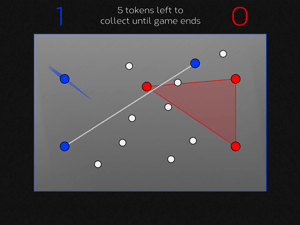I’ve made prototypes for local multiplayer games with 10+ people before – some very successfully, some less so, but always with great pleasure. There is something magical about a crowd of people all playing the same game together. You don’t just need to design good mechanics though – the game should balance well with a few or with a lot of people, which is also hard to test because you always need a crowd. Another problem is input: While yelling with varying volume in Screamy Bird is tremendously fun, it is a bit limited control-wise. Unless your crowd is very small, giving everyone a gamepad is not an option. But these days, most people have a smartphone with a web browser, and luckily, platforms like AirConsole and HappyFunTimes make using these as controllers extremly easy!
My goal was to make a game where people have to cooperate and that scales well with different amounts of players. To ensure cooperation, the game would feature two radically asymmetric roles: the Shooter, which can attack but dies to a single hit, and the Defender, which has no offensive capabilities, but whose shield can absorb any amount of damage. In the center of the games are the Cores which the players have to defend. Enemies come in from all around the screen and try to destroy the players and the Cores, whatever is nearest. The enemies’ projectiles are heat-seeking – they will always hit something, so without the Defenders, the Core and the Shooters will be destroyed rather sooner than later; but without the Shooters, the defenders could not destroy a single enemy.
This was a jam game done in about 12 hours and everyone around me was busy, so I there was no way I could balance it properly. I solved that dilemma by assuming the role of the game master: I would sit at the keyboard and spawn enemies.
Apart from troublesome connection problems, the game worked rather well for a jam game and the crowd loved it. Here is a video of the presentation:
The video was filmed by Iwan Gabovitch and the sound effects are from the fabulous Universal Sound Effects which I can very much recommend.
Connection problems aside, I am very content with how the mechanics worked out and I think there is a lot of potential there. I will probably revisit this prototype some day and make a proper game out of it.





